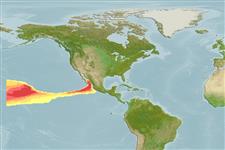Classification / Names
Common names | Synonyms | Catalog of Fishes(genus, species) | ITIS | CoL | WoRMS | Cloffa
Teleostei (teleosts) >
Stomiiformes (Lightfishes and dragonfishes) >
Stomiidae (Barbeled dragonfishes) > Melanostomiinae
Etymology: Eustomias: Greek, eu = good + Greek, stoma = mouth (Ref. 45335); curtatus: Named for its dimunitive projection of the bulb and the short barbel..
Environment: milieu / climate zone / depth range / distribution range
Ecology
Marine; bathypelagic; depth range 0 - 1000 m (Ref. 11333). Deep-water
Eastern Central Pacific: vicinity of Hawaii.
Size / Weight / Age
Maturity: Lm ? range ? - ? cm
Max length : 15.2 cm SL male/unsexed; (Ref. 11333); 15.3 cm SL (female)
Dorsal soft rays (total): 25; Anal soft rays: 40; Vertebrae: 68. A single terminal bulb, its length more than twice its width, with a very short or no terminal projection. Bulb and projection combined 0.4-1.6% SL. Barbel 35-57% SL. Axis of stem moderately pigmented proximally, usually becoming lighter distally. External chevron-shaped or roundish striated areas unpigmented, becoming closely spaced distally. Spherical to ovoid inclusions present in distal half of stem, small and widely spaced proximally, becoming fairly crowded distally, difficult to discern in specimens smaller than about 9 cm SL. Middorsal paired spots between occiput and dorsal-fin origin 8, sometimes 7 or 9 (Ref. 11333).
Mesopelagic (Ref. 58302).
Life cycle and mating behavior
Maturities | Reproduction | Spawnings | Egg(s) | Fecundities | Larvae
Gibbs, R.H. Jr., T.A. Clarke and J.R. Gomon, 1983. Taxonomy and distribution of the stomioid fish genus Eustomias (Melanostomiidae), I: subgenus Nominostomias. Smithson. Contrib. Zool. 380:139 p. (Ref. 11333)
IUCN Red List Status (Ref. 130435)
Threat to humans
Harmless
Human uses
Tools
Special reports
Download XML
Internet sources
Estimates based on models
Preferred temperature (Ref.
123201): 5.5 - 13.6, mean 7.8 °C (based on 6 cells).
Phylogenetic diversity index (Ref.
82804): PD
50 = 0.5000 [Uniqueness, from 0.5 = low to 2.0 = high].
Bayesian length-weight: a=0.00302 (0.00117 - 0.00783), b=3.12 (2.89 - 3.35), in cm total length, based on LWR estimates for this (Sub)family-body shape (Ref.
93245).
Trophic level (Ref.
69278): 4.3 ±0.8 se; based on size and trophs of closest relatives
Resilience (Ref.
120179): Medium, minimum population doubling time 1.4 - 4.4 years (Assuming tmax>3).
Fishing Vulnerability (Ref.
59153): Low vulnerability (10 of 100).
